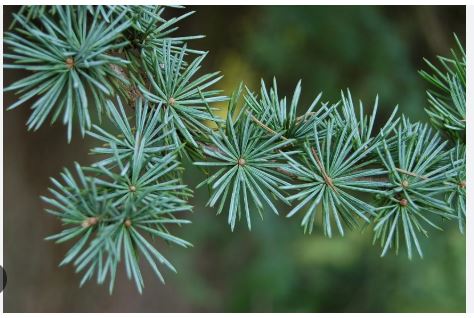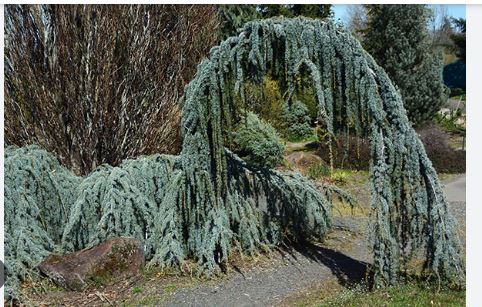
Botanical Classification
The Atlas Cedar, scientifically known as Cedrus atlantica, belongs to the Pinaceae family, which includes pines, firs, spruces, and other conifers. It is part of the genus Cedrus, encompassing true cedars such as the Lebanon Cedar (Cedrus libani) and Deodar Cedar (Cedrus deodara). Commonly referred to as the Atlas Cedar or blue Atlas Cedar (particularly for the glaucous cultivar ‘Glauca’), Cedrus atlantica is an evergreen coniferous tree valued for its ornamental and ecological qualities. Its classification within the order Pinales places it among ancient conifers, with a lineage tracing back to the Tertiary period. The species name “atlantica” reflects its native range in the Atlas Mountains of North Africa.
History
The Atlas Cedar has a significant history tied to North African ecosystems and European horticulture. Native to the Atlas Mountains, it was revered by Berber communities for its durable wood and resin, used in construction and traditional medicine. Introduced to Europe in the early 19th century, it gained popularity in Victorian gardens for its stately form and striking blue-green foliage, particularly the ‘Glauca’ cultivar. By the 20th century, it became a staple in ornamental landscaping across Europe and North America. Its ecological role in stabilizing mountainous soils and its cultural significance in Morocco and Algeria have made it a symbol of resilience, though overexploitation and climate change threaten wild populations.
Identifying Characteristics
Cedrus atlantica is a large, evergreen conifer, typically growing 40–120 feet tall with a trunk diameter of 3–6 feet. Its needle-like leaves are short (0.5–1 inch), stiff, and arranged in dense clusters of 20–40 on short shoots, varying from green to silvery-blue (especially in ‘Glauca’). The bark is grayish-brown, fissured, and scaly with age. The tree produces upright, barrel-shaped cones (2–3 inches long), green when young, maturing to brown and disintegrating on the tree. Its pyramidal crown in youth broadens into a flat-topped, irregular shape with age, with gracefully drooping branches adding to its majestic appearance.
Distribution and Ecology
Native to the Atlas Mountains of Morocco and Algeria, Cedrus atlantica grows at elevations of 4,000–8,500 feet in cool, moist montane forests. It thrives in well-drained, rocky, or sandy soils, often on steep slopes, and tolerates Mediterranean climates with wet winters and dry summers. The tree forms pure stands or mixes with oaks, pines, and junipers, providing habitat for birds, small mammals, and insects. Its deep roots stabilize soils, preventing erosion in rugged terrain. However, habitat loss, overgrazing, and climate-induced drought have reduced wild populations, making conservation efforts critical. Introduced populations are widespread in temperate regions as ornamental trees.
Uses
Atlas Cedar has diverse ornamental, ecological, and industrial uses. Its durable, aromatic wood is used for furniture, cabinetry, and construction, though commercial harvesting is limited due to conservation concerns. The wood’s essential oils are extracted for perfumes and aromatherapy, valued for their woody, resinous scent. Ornamentally, it is widely planted in parks, estates, and large gardens for its striking foliage and architectural form, with cultivars like ‘Glauca’ prized for their blue hue. Ecologically, it prevents soil erosion and supports montane ecosystems. In traditional medicine, its resin and oils have been used for antiseptic and respiratory treatments, though this is less common today.
USDA Zones
Cedrus atlantica is hardy in USDA Zones 6–9, thriving in cool to warm temperate climates with mild winters and moderate summers. It tolerates temperatures as low as -10°F, making it suitable for regions like the Pacific Northwest, parts of the Northeast U.S., and southern Europe (Zone 6). Zones 7–9, including Mediterranean climates and the southeastern U.S., are ideal for its growth. The tree requires full sun and well-drained soils, tolerating drought once established but sensitive to waterlogged conditions. In colder zones, it may be grown in protected microclimates, though its large size limits container cultivation.

Cultivation of Atlas Cedar
- Climate Suitability: Atlas Cedar thrives in USDA Hardiness Zones 6–9, preferring temperate climates with mild summers and cool winters. It tolerates temperatures down to -10°F (-23°C) but struggles in extreme heat or humidity.
- Site Selection: Choose a location with full sun exposure (at least 6 hours daily) for optimal growth. Partial shade is tolerated but may slow development and reduce vigor.
- Soil Requirements: Plant in well-drained, slightly acidic to neutral soil (pH 5.5–7.0). It adapts to sandy, loamy, or rocky soils but dislikes heavy clay or waterlogged conditions.
- Planting Time: Spring or early fall is ideal for planting to allow root establishment before extreme weather. Dig a hole twice the width and equal depth of the root ball, ensuring the root collar sits at ground level.
- Watering Needs: Water young trees regularly (weekly for the first 1–2 years) to keep soil moist but not soggy. Mature trees are drought-tolerant but benefit from occasional deep watering during prolonged dry spells.
- Mulching: Apply a 2–3 inch layer of organic mulch (e.g., bark or wood chips) around the base, keeping it away from the trunk. Mulch conserves moisture, regulates soil temperature, and reduces weeds.
- Fertilization: Fertilize sparingly, as Atlas Cedars are not heavy feeders. Use a balanced, slow-release fertilizer (e.g., 10-10-10) in spring for young trees. Avoid over-fertilizing, which can cause weak growth.
- Pruning: Prune minimally to maintain shape or remove dead, damaged, or crossing branches. Perform light pruning in late winter or early spring before new growth begins. Avoid heavy cutting, as cedars do not readily sprout from old wood.
- Pest and Disease Management: Monitor for pests like aphids, scale insects, or cedar weevils, and treat with insecticidal soap or neem oil if needed. Prevent fungal issues (e.g., root rot) by ensuring proper drainage. Inspect regularly for needle blight or canker.
- Spacing: Space trees 20–30 feet apart to accommodate their mature spread (up to 40 feet wide). This prevents overcrowding and ensures good air circulation, reducing disease risk.
- Wind Protection: Young trees are susceptible to wind damage due to their shallow roots. Stake them for the first 1–2 years in windy areas, but remove stakes once established to encourage strong root development.
- Winter Care: In colder climates, protect young trees from winter burn by wrapping them in burlap or applying an anti-desiccant spray. Ensure adequate soil moisture before winter to prevent dehydration.
- Long-Term Growth: Atlas Cedars grow slowly to moderately (1–2 feet per year) and can reach 40–60 feet tall (or more) at maturity. Plan for their large size, as they are unsuitable for small landscapes but ideal for open spaces or as specimen trees.